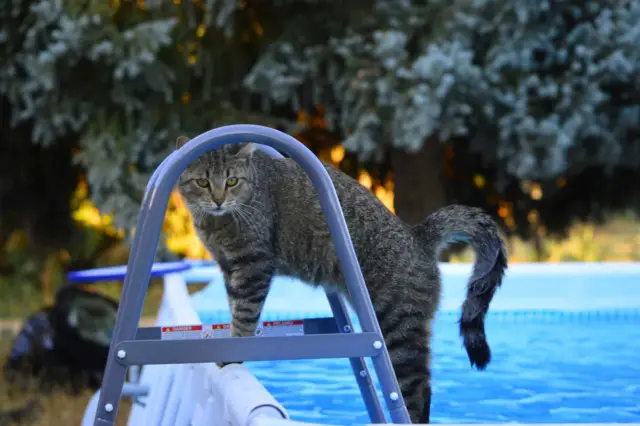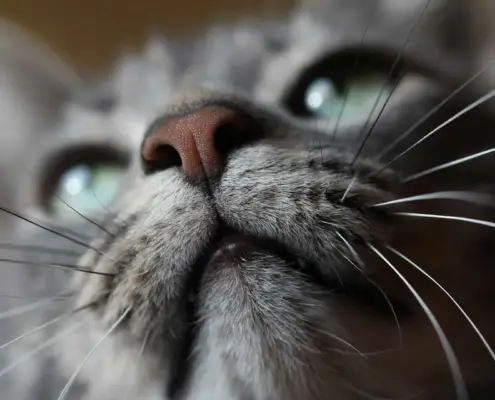
When one thinks of cats, swimming is not typically the first activity that comes to mind. Cats are known for their elegance, agility, and aversion to water. However, there is a common misconception that all cats despise water and are unable to swim. In this article, we will delve into the world of feline swimming abilities, exploring the truth behind this myth and shedding light on the fascinating relationship between cats and water.
Understanding the anatomy of cats and its impact on swimming
To understand a cat’s swimming ability, it is crucial to examine their anatomy. Cats possess a unique bone structure and muscular system that grants them remarkable agility and flexibility. However, these physical traits are not specifically designed for swimming. Unlike their canine counterparts, cats lack webbed feet and a natural inclination towards water-based activities.
The structure of a cat’s skeleton, specifically the spine and limbs, is designed for balance and precise movement on land. Their powerful hind legs allow them to leap and pounce with unrivaled grace. While these attributes make cats exceptional hunters, they are not ideal for propelling themselves through water efficiently. This inherent physical design contributes to the general belief that cats are not natural swimmers.
The natural instincts of cats and their relationship with water
Cats are instinctively aware of the potential dangers water poses to their well-being. Their fur, although providing insulation, becomes waterlogged and hampers their ability to stay afloat. Furthermore, cats are meticulous groomers, and water can disrupt the essential oils on their skin, leading to discomfort and potential health issues.
However, there are exceptions to every rule. Some feline species have developed an affinity for water due to their geographical location or specific genetic traits. It is important to acknowledge that while most cats may be averse to water, there are notable exceptions that challenge the stereotype.
Famous cat breeds known for their swimming abilities
Certain cat breeds have gained recognition for their surprising affinity for water. The Turkish Van, for instance, hails from the rugged region of Eastern Turkey, where swimming is a necessity. These cats possess a unique texture to their fur, which repels water and enables them to stay buoyant. Their playful nature and natural curiosity often lead them to explore bodies of water fearlessly.
Another breed known for its swimming prowess is the Bengal cat. Originating from the Asian leopard cat, this breed inherited its ancestor’s love for water. Bengals are often seen dipping their paws into water bowls or confidently taking a dive in a nearby pool. Their sleek, water-resistant coat and muscular build make them adept swimmers, challenging the notion that all cats loathe water.
Can all cats swim? Exploring the individual differences
While certain cat breeds may exhibit a natural inclination towards swimming, it is essential to remember that each cat is an individual with unique preferences and characteristics. Just as some humans are more comfortable in the water than others, the same applies to felines. Some cats may be more open to water-related activities, while others may vehemently resist any form of aquatic interaction.
It is crucial to understand and respect your cat’s boundaries when it comes to water. Forcing a cat into a swimming situation can cause stress and potentially harm the bond between the cat and its owner. It is always best to introduce water-related activities gradually and observe your cat’s reactions and comfort levels.
Tips for introducing your cat to water and swimming
If you wish to introduce your cat to water or encourage swimming, it is vital to proceed with caution and patience. Here are some tips to help you navigate this process:
- Start slow: Begin by allowing your cat to explore water in a controlled environment, such as a shallow basin or a bathtub. Gradually increase the depth as your cat becomes more comfortable.
- Positive reinforcement: Use treats and praise to create a positive association with water. Reward your cat for calm behavior and small steps towards water exploration.
- Gentle introduction: Slowly introduce your cat to the sensation of water by using a spray bottle or a damp cloth. This gradual exposure can help desensitize them and make the transition smoother.
- Provide a safe space: Ensure your cat has an easy escape route and a dry, warm area nearby. This will give them a sense of security and minimize any anxiety they may experience.
Remember, not all cats will take to water or swimming, and it is crucial to respect their individual preferences and comfort levels.
The benefits of swimming for cats
Swimming can offer several benefits for cats, both physical and mental. Engaging in water-related activities can help cats stay active, maintain a healthy weight, and improve muscle tone. The resistance provided by water offers a low-impact workout that is gentle on their joints.
Furthermore, swimming can be an enriching experience for cats, stimulating their senses and providing mental stimulation. Exploring a new environment and engaging in water play can help alleviate boredom and prevent behavioral issues that may arise from a lack of mental stimulation.
Safety precautions for cat swimming sessions
While swimming can be a rewarding experience for some cats, it is crucial to prioritize their safety. Here are some safety precautions to consider:
- Supervision: Always supervise your cat during swimming sessions. Accidents can happen, and it is essential to be present to ensure their well-being.
- Appropriate water temperature: Ensure the water is at a comfortable temperature for your cat. Cold water can be distressing and potentially harmful to their health.
- Gradual acclimatization: Allow your cat to acclimate to the water gradually. Rushing the process can cause stress and anxiety.
- Avoid strong currents: When swimming in natural bodies of water, be cautious of strong currents or undertows that can pose a risk to your cat’s safety.
By adhering to these safety precautions, you can provide a safe and enjoyable swimming experience for your feline companion.
Popular cat swimming videos and their impact on the perception of cat swimming abilities
In the age of social media, cat videos have become a global sensation, captivating audiences worldwide. Among the vast array of cat videos, there are numerous clips showcasing feline swimming abilities. These videos often go viral, contributing to the popular perception that cats universally despise water.
However, it is crucial to remember that these videos represent a small fraction of the feline population. While they may be entertaining and showcase the unique abilities of individual cats, they should not be taken as a reflection of the entire feline species.
Embracing the unique traits and abilities of cats
In conclusion, the myth that cats universally despise water and cannot swim is just that—a myth. While most cats may have an aversion to water due to their anatomy and natural instincts, there are exceptions to this generalization. Some cat breeds have developed an affinity for water, challenging the stereotype. However, it is crucial to remember that each cat is an individual, and their comfort and preferences should always be respected.
If you wish to introduce your cat to water-related activities, do so gradually and with patience. Always prioritize their safety and well-being, and never force them into a situation they are uncomfortable with. Embrace the unique traits and abilities of each cat, and celebrate the diversity within the feline world.
If you enjoyed my article, I would appreciate you sharing it with your network.

Sima Ndlebe
Sima writes for CatBuzz. He is interested in Cats, Health and Fitness, and Entrepreneurship.
Published: 25 April 2024




